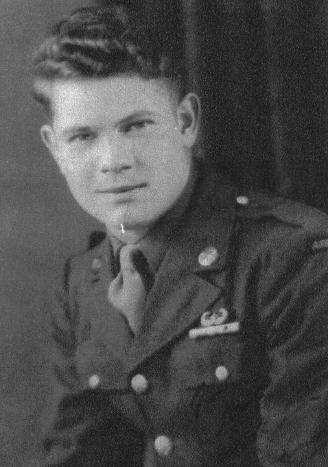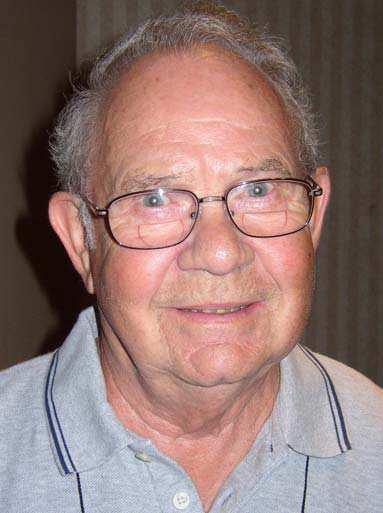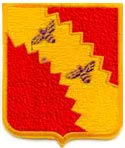
JOHN D KAMINSKI
|
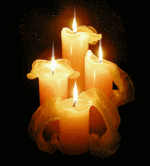
IN MEMORIAM |
|
It's with great sadness that I announced,
the
4th July, John passed away.
If you pass here, stop you 5 minutes and
think of what Great Man made for you.
I would never forget you John, Thank you for all!
|
One very thank you to John Kaminski to
have agreed to answer my very numerous questions! For his kindness and its
availability!
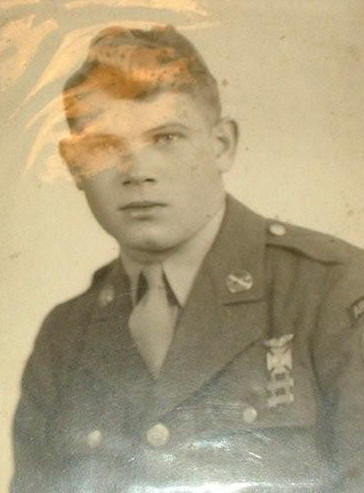 <-John
in the 40'S
<-John
in the 40'S
and today ->
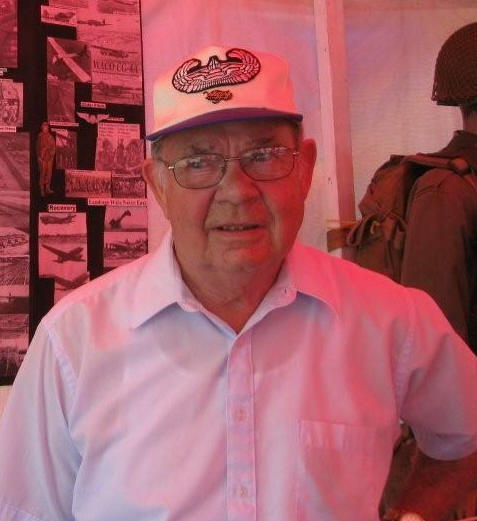
John D. Kaminski was born on June 24th in South Park, Ohio. When he
was 4 years old, the family moved to Cleveland, Ohio.
“It was the period of the Great Depression. We always had a home and food on the
table.
Dad worked in a foundry.”
He attended classes at South High School in Cleveland, Ohio. On 16 April 1943,
he was called to serve his homeland. He was sent to Fort Hayes in Columbus,
Ohio. He was then sent to Camp Mackall, North Carolina.
“On April 20, 1943 I went to the 17th Airborne Division. I was
assigned to the 680th Battery B glider field artillery.”
John Kaminski thus followed the Glider troop’s training, consisting of running,
swimming lessons, various challenges on the ground, and of course, using the
entire range of equipment. Then followed the training on gliders, loading and
unloading equipment, stowage of material and thus training to tie good knots.
Some of the exercises took place at night practicing the tying of loads into the
gliders in the dark.
John also followed the basic training of the artillerymen which includes the
transport of 75mm Howitzers.
“During basic we used the Howitzer as part of our exercise. We had a special
Harness to pull the Howitzer thru the sandy fields and roads in North Carolina.
It took our crew of seven men to pull it. Each gun section had a crew of seven
men and one driver to handle the Howitzer. At this time we had wheels that were
made of wood with an iron rim to hold it together. We received rubber wheels in
England. Twenty five mile marchs were common. But I will always remember the
five mile march that had to be done in one hour. This had to be done with a
full field pack and we could not do any running, only a fast walk. We were
trained to dismantle and assemble a 75MM Howitzer which we took into
combat during the Battle of the Bulge. We also dismantled and assembled
a sawed-off 105MM Howitzer which we took in our Glider when we crossed the Rhine
River during Operation Varsity.”
He was then sent to the Maxton airport to participate in the first flight. John
remembers very well the gliders’ flight training. All the flights went well.
“To most of us it was the first time in the air. Quite a thrill. Then days of
Glider flights, it was the beginning of the 17th airborne.”
In February, John Kaminski was sent with his unit buddies to Tennessee to
participate in maneuvers.
“Maneuvers in Tennessee were a great training experience. We were wet and cold
and tired most of the time but when we got into combat, we were thankful for the
training we received during maneuvers."
“On
March 27, 1944 we returned to garrison at Camp Forrest, Tennessee. In August
1944 we were sent to Camp Miles Standish for shipment to the European theatre of
operations.”
On August 20th, 1944 the troops embarked on a troop carrier in the direction of
England. The convoy under escort took off to good speed to escape the threat of
German’s U-Boats.
“We arrived a Liverpool, England on August 26, 1944 and were billeted at Camp
Chisledon, England.”
This period of tranquillity in England will brutally come to an end in December,
1944. The Germans launched their last offensive on December 16th
1944. The 17th is called to the rescue.
On the 24 December 1944, the B battery of the 680th GFAB
took off from an English airport in direction of a French airport situated
outside of Bets.
“On Christmas day we took off on the C-47 and one of our C-47 with six men had
risen a few feet off the ground and then plunged back to the earth. While flying
over Paris we received a radio report that another plane was forced to land.”
John does no longer remember the name of the airport on which he landed in
France. He remembers that trucks waited for them to drive to Mourmelon.
“It was during our move that we suffered our first actual casualities. Our
column was strafed by the Germans and two of our men were killed.”
Then, during a long march, the unit arrived at Sibret in Belgium. The weather
was dreadful. A snowstorm swept the Ardennes.
“We were not equipped for a hard winter. We had Field Jackets and an overcoat
but no winter boots and we suffered from frozen feet.”
In this first position, John Kaminski also had his first fear and his first
meetings with enemies. Indeed, the German snipers were present.
At this place began the offensive baptized later the Battle of Dead Man's Ridge
that cost the life of many men of the 17th Airborne Division.
“My most memorable
event during the Battle of the Bulge was at Dead Man’s Ridge, where some of the
worst fighting of the Bulge took place. It was here while we were in this
position that the battery received a call that two German Tiger Tanks were
headed for our position. The second Gun Section was told to leave our position
and to move forward about two hundred yards and dig our gun in to stop the
tanks. We moved forward and dug in and waited. Thank goodness the tanks turned
before they got to our position. Later we found out that the shells we had were
not armor piercing.”
“I can remember that we fired a lot of shells in support of our infantry and
when got to the top of the ridge we found scores of dead Germans.”
Then the unit moved again. From January till February, the unit moved in support
of the 513th PIR almost everywhere in the Belgian Ardennes, and among others,
went through Mande, Bastogne, Steinbach to finally end up in Luxembourg.
“We had no contacts with any civilians.”
On February 12th, 1945, John Kaminski and his unit leave the front for Chalon
sur Marne, France. There, the unit re-equips and receives the replacements for
the troopers killed in action in the Ardennes.
“We made our departure from combat on February 12, 1945. Yes going back to
France after two months of ice, rain, snow and cold. We started drill,
calisthenics and we acquired the new M3-105 Howitzer.”
“I was one of the lucky ones that received a 15 day pass to London, England. I
had a back pay of 3 months. I blew it all on Hotel rooms, Black Market Steaks,
and Etc. I knew that when I got back to France we would be air dropped
somewhere in Germany.”
“On March 21, 1945 we arrived at the marshalling area. It was at the side of
the Chateaudun airport. It was heavily guarded by M.P.S. We could not get out
and they could not get in.
Here we were given our briefing. We loaded the Gliders and then checked and
rechecked the ropes and chains that held the equipment to the Glider.”
On March 24th, 1945, John Kaminski embarks on his glider along with Sergeant
Buckley. His glider transports one of the 105mm Howitzers which will serve
during the battle.
“Our Captain Stahl gave a last minute message (which I will never forget) he
said some of us will pass on before this night. But God grants us the very best
of luck and I know B Battery will come through. He mentioned his supreme pride
in his battery. (Captain Stahl died that day).”
The first glider took its flight at 7:45 am. After two hours of animated flight,
the armada was in the aim of the Rhine River and the objective. At about 10:30
am, the pilot informed them that he was flying over the Rhine River and the
gldier was soon to be released from the C-47. The C-47 dragging John's glider
also dragged another glider transporting the Jeep that had to convey the 105mm
Howitzer.
“Then it started, from nowhere came the thunder of guns, the echo of
explosions. The rumble of death, flak, tons of it burst around us and slithered
its way through the canvas of the flying coffins. Many Gliders lit up like
torches and we prayed.”
“Our Glider was hit many times by small arms and flak. Most of the flak and
small arms hit the tail of our Glider, so our Glider pilot was able to make a
safe crash landing.”
At 12:20 pm, his glider lands hard on the German ground. Directly, the fight is
engaged with the enemy.
“Once on the ground, one knew he must get out of the Glider quickly or he was
lost. So it did not take long. We were able to extract the Howitzer in a matter
of minutes. Heine mortars opened up, if they missed the first time, the next
shell would take the Glider and blow it to a million pieces. Small arms and
machine guns were present and their warnings of death kept all on the alert.”
“The Glider holding the Jeep crash landed near us. In only a few minutes and we
were able to hook the howitzer to the Jeep. In the mean time we were receiving
small arms fire from nearby houses near the field. When we moved the Howitzer to
the edge of the field were able to unhook the howitzer from the Jeep, and then
we were able to fire at the homes that the small arms fire was coming from. A
few well aimed shots from the howitzer and the firing ceased.”
“But buddies were being hit, even though Jerry was paying a heavy toll. It took
several hours before points of resistance were wiped out and prisoners rounded
up. There was a gore of war everywhere, death and destruction, chaos and
confusion. It was not until 1500 or later that we became a unit capable of
action: and then there was plenty of it. So that was it, we lost heavily, but in
turn we had handed our share of revenge.”
“The 680th Glider Field Artillery Battalion received the Presidential
Unit Citation Battle Honors.”
After Varsity, the 17th Airborne Division pushed away the Germans. They chased
the Germans on trucks and tanks, hitting quick and hard.
Once passing by Wesel, the division progressed towards the northeast,
penetrating 15 miles further into the heart of Germany.
“Almost to Munster, where we stopped a German counter attack. After this we
moved back to help clean up the huge Ruhr pocket.”
“After a few weeks in the Ruhr pocket, we moved to Velen to occupy the town.”
One week later, John Kaminski's battery was sent behind the front to take back
the town of Walsum near Dinslaken and serve as Military Government.
The end of the War approached. In the meantime, John spent his days on guarding
and patrol duty.
“Then on May 6th the radio told us the was over. We were in Walsum
when VE day was declared as May 6, 1945. This was the day we waited for.”
The next days were not different. John Kaminski lived a life of garrison in
Walsum. It was a beautiful and good period but with inconveniences.
“The non-fraternization policy. As much as we disliked the German race and
ideals. We are still human and susceptible to a female’s charms. It was torture
but most of us survived the ordeal, I think?”
The number of casualties in John's B battery amounted to 15 soldiers killed in
action and John remembers 5 wounded over a total of 209 soldiers.
“I was one of the lucky ones, I was not
wounded. The only thing, was during a shelling of our position during the
Battle of the Bulge, I could not hear for two days. I was at a first aid
station for two days when my hearing was restored and I went back to the front
line.”
During this Military Government’s period, John Kaminski and his unit buddies had
the responsibilities to look after the people who had been held in camps by the
Germans.
“These were people that the Germans brought in to work in their shops & mines,
Etc. They were worked as slaves and were not
well fed. Our section was given the job of protecting the German farmers from
the Russians that left the camp at night to search for food and to kill
German women and children. Note we fed the Russians well and there was no need
to search for food.”
About the German soldiers:
“My job there was to get rid of the German soldiers, so that we would have peace
in the world and we all could go home. Beside my Mom always told me that if I
could not say any thing good about a person that I should say nothing.”
His mission accomplished, John learned that his division would be disbanded.
Part of it would be sent to the 82nd Airborne Division and would serve as troop
of occupation in Berlin and the rest would be sent to the 101st Airborne
Division which will be participating in the invasion of Japan. John, as well all
the soldiers of his battery were sent as replacements to the 101st Airborne
Division.
“We were sent to a camp outside of Marseille, France to board a liberty ship to
take us to Okinawa. This would take us two months to get there. We boarded
the ship on August 1 but we got to the Mediterranean Sea, the ship broke down
and we were towed back to Marseille, France. While there on Aug 6th,
1945 THE First Atomic bomb was dropped on Japan. A second bomb was dropped a
few days later (Amen!) on Japan. Once again we boarded the liberty ship and
sailed out to the Mediterranean Sea and then to the Atlantic Ocean. When in the
middle of the Atlantic Ocean Japan surrendered and the ship turned north and
sailed to Boston USA. To Camp Miles Standish on September 2, 1945. There we
received a thirty day furlough home.”
Back from his 30 days of furlough, John Kaminski is sent to Fort Bragg, North
Carolina. He stayed until December, 1945 and then went to the Separation Center
at Camp Atterbury in Indiana.
He was demobilized on December 21st, 1945. He directly returned home. After the
war, John Kaminski returned to work at the factory. But he will only stay there
two weeks, he decided to take advantage of the GI Bill to go back to school.
He went to several schools. He attended classes of accounting, Taxes, IBM Data
Processing and computer sciences.
“At the same time I worked as a furniture salesman. After completing the college
courses I took a position with the largest bank in Ohio (Cleveland Trust Co).”
John Kaminski started out as an IBM Operator and finished as an assistant vice
president.
He retired at the age of 59.
“About three weeks after I retired I was asked to return
to the bank as a consultant. That job lasted 15 years and that’s when I retired
for good from the bank.”
John was married with Sophie for 60 years, they had a son who is now married but
who has no children.
Unfortunately, Sophie died in September, 2007.
“I
live alone, I go to a recreation Center at least 4 times a week. I walk at least
a mile a day and swim at least an hour. During the summer months I go to the
towpath that is located by a Canal. There I walk at least 3 miles. I have quite
a few friends that are always inviting me out some where. My home town is
Garfield Heights, Ohio. It is a Suburb of Cleveland on the shores of Lake
Erie.”
John Kaminski is also involved with several veterans associations, The Veterans
of Foreign War, and the 17th Airborne Association of which he has been a member
for 50 years.
“We
met once a year at various locations in the United States. When it first started
out we had a few thousand troopers and their families attend the reunion. Our
last reunion was in 2007 in Norfolk, VA. Which is when we disbanded. We had
around 700 people attend, 200 Troopers and the rest were Families. I still keep
in contact with 7 members of the Battery B by phone. They live all over the
States from Maryland to California.”
Of the war, John only has memories but also some pictures, his Bible, a copy of
the Star and Stripes newspaper, his pay record and a piece of parachute.
“I have a Nazi Flag, and various German medals.”
John Kaminski was awarded the Good Conduct Medal, with the Presidential Unit
Citation, American Campaign Medal, European-African-Middle Eastern Campaign
medal, WWII Victor Medal, Army of Occupation Medal, Badge of Glider, Badge of
Marksman, Honorable Lapel,and 3 Bronze Stars and Indian Arrowhead for the Rhine
River crossing.
John never returned to Europe, although he once had the opportunity but was not
interested at the time.
“I guess I never will.”
“The
war was a great experience, I met a lot of great guys that I will never forget.”
